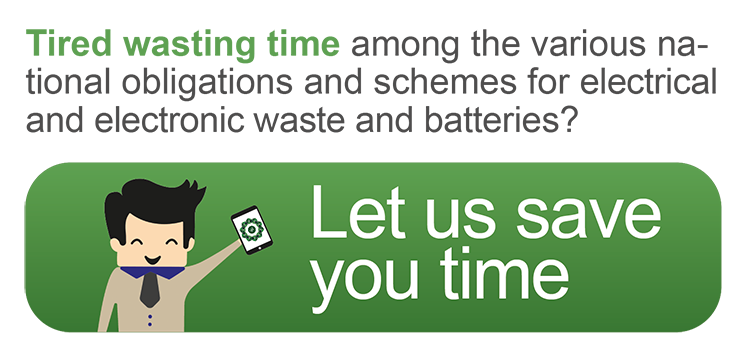Impact of Open Scope for producers of Waste Electrical and Electronic Equipment
Does it really change anything?
From August 15th 2018, the WEEE directive changes its method of determining the products covered from a closed, defined scope to an ‘open scope’.
From 2006 until August 15th 2018, material covered under the WEEE sector was defined in a list of industry categories (10 categories as per Annex 2 of WEEE directive 2012/19/EU). A degree of interpretation was possible, which led to some companies considering their products as outside of the industry scope.
From August 15th 2018, WEEE directive 2012/19/EU changes the product categorization to a so-called 'Open Scope' with WEEE categories revised and developed with a view to simplification.
A change of this order raises many questions:
How will it affect existing WEEE-compliant producers?
What are the implications for products that are ‘new’ to the market?
Will equipment previously considered ‘out of scope’ now be ‘in scope’?
How do we go about categorizing products under the new Open Scope system?
Is there a deadline to adapt existing products (if necessary) to Open Scope?
How does one determine if a product or item of equipment is in or out of Open Scope?
Back to basics: what is EEE?
According to article 3.1(a):
“‘electrical and electronic equipment’ or ‘EEE’ means equipment which is dependent on electric currents or electro-magnetic fields in order to work properly and equipment for the generation, transfer and measurement of such currents and fields designed for use with a voltage rating not exceeding 1000 volts for alternating current and 1500 volts for direct current”
This definition is unchanged since the first WEEE directive. Open Scope will only exclude equipment that is specifically excluded under the directive (articles 3 and 4 of directive 2012/19/EU), as follows:
- equipment necessary to protect the essential security interests of Member States, including arms, munitions and other war material intended for specifically military purposes;
- equipment specifically designed and installed as part of another type of equipment that is excluded from or does not fall within the scope of the WEEE Directive 2012/19/EU, which can fulfil its function only if it is part of that equipment;
- filament bulbs;
- equipment designed to be sent into space;
- large-scale stationary industrial tools;
- large-scale fixed installations, except any equipment which is not specifically designed and installed as part of those installations;
- means of transport for persons or goods, excluding electric two-wheel vehicles which are not approved;
- non-road mobile machinery intended exclusively for professional use;
- equipment designed solely for the purposes of research and development that is only made available in a business-to-business context;
- active implantable medical devices as well as medical devices and in vitro diagnostic medical devices, where such devices are expected to be infective prior to end of life.
Open Scope means that EEE products are a priori considered to be in scope unless specific exclusions apply.
What happens for existing producers that are currently compliant? There is no change for the present. Equipment previously classified under WEEE is now in Open Scope. Eventually a change of product categorization will be required.
What happens in respect of producers who previously considered their products as out of scope? They will need to reassess to see if their products now fall under Open Scope. See above exclusions.
What happens to kits composed of several items of equipment?
They fall under WEEE Open Scope.
What happens to spare parts and components?
Mother boards, graphic boards, electrical and electronic components sold individually to replace a similar product fall under WEEE Open Scope unless contrary advice is in place from the local authority.
Analysis:
Producers and businesses already registered and WEEE compliant may be affected by Open Scope insofar as product categorization could change and they might then need to modify the category of WEEE reported when placing a product on the market.
What are the new categories coming into use on August 15th 2018?
- Heat exchange equipment
- Screens, monitors, and equipment containing screens having a surface area greater than 100cm2
- Lamps
- Large equipment (any external dimension greater than 50 cm) including but not limited to:
Household appliances; IT and telecommunication equipment; consumer equipment; light fixtures; equipment reproducing sound or images, musical equipment; electrical and electronic tools; toys, leisure and sports equipment; medical devices; monitoring and control instruments; automatic dispensers; equipment for the generation of electric currents. This category does not include equipment included in categories 1 to 3.
- Small equipment (no external dimension greater than 50 cm) including but not limited to:
Household appliances; consumer equipment; light fixtures; equipment reproducing sound or images, musical equipment; electrical and electronic tools; toys, leisure and sports equipment; medical devices; monitoring and control instruments; automatic dispensers; equipment for the generation of electric currents. This category does not include equipment included in categories 1 to 3 and 6.
- Small IT and telecommunications equipment (no external dimension greater than 50 cm)
[EN L 197/58 Official Journal of the European Union 24.7.2012]
When does Open Scope come into force?
European member states will need to adapt their national WEEE OPEN SCOPE
registries to reflect both Open Scope itself and the new Open Scope categories. The modifications involved are currently being clarified in each member state.
Estimated deadlines:
- January 1st 2018: Austria, Belgium, Bulgaria, Croatia, Denmark (new products to be registered by August 15th 2018; new categories January 1st 2018), Finland (product registration from August 15th 2018; reporting-ready since Q1 2018), France, Germany, Greece (product registration no later than August 2018; categories ready since 2016), Finland, Hungary, Italy, Poland, Slovenia, Spain
- January 1st 2019: Czech Republic, Estonia, Ireland, Sweden, United Kingdom
- Dates not yet disclosed: Cyprus, Latvia, Lithuania, Malta, Portugal, Romania, Slovakia,

Where producers had considered certain items of their equipment as out of scope because they did not fit well with the old categories, these are no longer out of scope unless a clear rationale for their exclusion can be given.
Romain Letenneur


